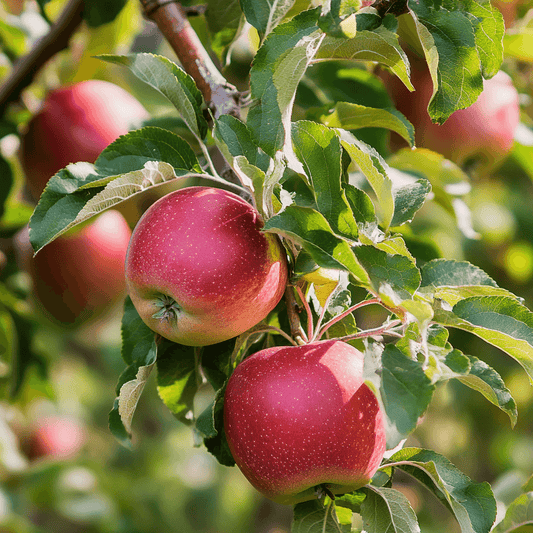Apple Trees That Thrive: Understanding Soil pH for Apple Trees and the Ideal Climate for Apple Trees
Growing apple trees successfully begins with understanding the soil and weather conditions they need to thrive. The right soil pH for apple trees and a compatible climate for apple trees make all the difference between struggling growth and abundant harvests. This guide covers how to match soil, weather, and care routines for healthy, productive trees that produce fruit year after year.

Do Apple Trees Like Acidic Soil?
Yes, apple trees like slightly acidic soil. The optimal soil pH for apple trees is between 6.0 and 6.5, which allows for balanced nutrient absorption and strong root growth. In soil that’s too acidic or too alkaline, trees struggle to take up essential nutrients like nitrogen, phosphorus, and potassium.
Learn more about how to test and adjust pH in Understanding Soil pH, and check your ground with Soil pH Testing Kits. If your soil’s pH needs tweaking, apply an organic pH-correcting fertilizer before planting apple trees.
Ideal Apple Soil Type
Apple trees prefer loamy, well-drained soil rich in organic matter. This balance of sand, silt, and clay holds moisture without becoming waterlogged. In sandy soil, blend in compost to improve water retention; in heavy clay, add compost or gypsum to improve drainage. High-quality soil amendments and natural bone meal fertilizers build a healthy root system and promote long-term fertility.

What Climate Do Apples Grow In?
The best climate for apple trees combines cold winters and warm, sunny summers. Cool weather triggers dormancy and satisfies chilling hours, while warm sunshine promotes flowering and fruit ripening.
Check your local hardiness zone and chill-hour totals with Fruit Tree Chill Hours Explained to ensure your chosen apple variety suits your area.
Apple Tree Climate Requirements
- Cold-Hardy Regions (Zones 3–5): Choose robust trees like Honeycrisp or Haralson that can withstand freezing winters.
- Moderate Climates (Zones 6–7): Varieties like Fuji or Gala thrive in mild winters with moderate chill.
- Warm Regions (Zones 8–10): Low-chill trees such as Dorsett Golden and Anna perform best where winters are short and warm.
For hot, dry regions, use shade fabric and mulch to conserve moisture and protect against sunburn. In cooler zones, add frost and sun protection for young trees during early spring.
Learn how to choose the right cultivar in Choosing the Right Apple Tree for Your Garden.

Planting Apple Trees the Right Way
Selecting the Perfect Size
When growing apple trees, consider available space.
- Dwarf apple trees are compact, easy to prune, and ideal for small yards or container growing.
- Semi-dwarf trees balance size and yield—great for family orchards.
- Learn more in Tree Size & Rootstock Options for Apple Trees.
When ready to plant, start strong with bare root apple trees. They establish quickly and adapt well to new soil.
How to Plant and Water
Dig a wide hole about twice the width of the root ball. Place the tree so that the graft union sits just above the soil line. Backfill with native soil and firm gently to remove air pockets. Water deeply to help roots settle, then mulch to retain moisture and regulate temperature.
Proper watering is key—see The Importance of Proper Watering in Organic Gardening for simple, effective methods.

How to Take Care of Apple Trees
Consistent care ensures your apple tree varieties stay healthy and productive. Give them full sun for at least six hours daily, prune yearly, and fertilize lightly in early spring and midsummer.
Pollination and Fruit Production
Most apple trees need a partner to pollinate effectively. Matching varieties with compatible bloom times boosts yield. Explore pairing tips in Pollinator Partners and Pairings for Apple Trees.
Managing Pests and Disease Resistance
Healthy apple growing depends on prevention and early action.
- Choose trees with natural disease resistance, as explained in Apple Tree Diseases and Disease Resistance.
- Protect your orchard in spring using Spring Disease Control in Your Orchard.
- Keep an eye out for pests like codling moths and apple maggots—learn how in Worms in Your Apples.
- Address bacterial infections quickly using Controlling Fire Blight Organically.
In Summary
The foundation of successful apple growing is simple: balance. Balanced soil pH, consistent watering, and climate-appropriate varieties yield healthy, productive trees. Choose a cold-hardy cultivar if you’re in a frosty region, or a low-chill apple variety if your winters are mild.
Site your planted trees in full sun, enrich your soil with organic matter, and stay ahead of pests and disease. With thoughtful planning and care, your orchard will produce fruit abundantly—sweet proof that great apples start with great soil and climate.










